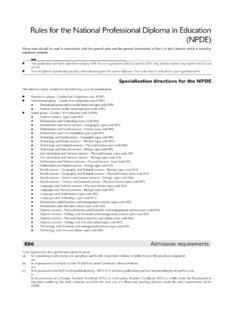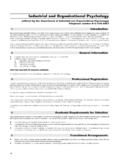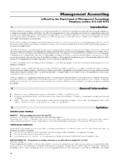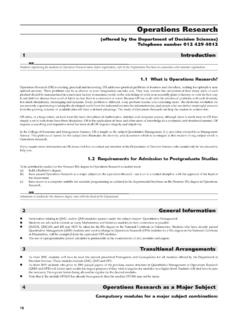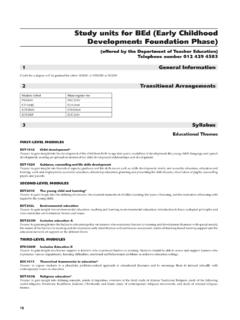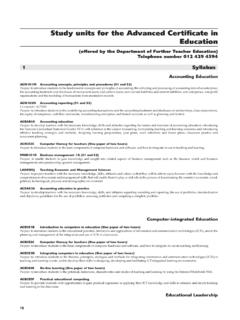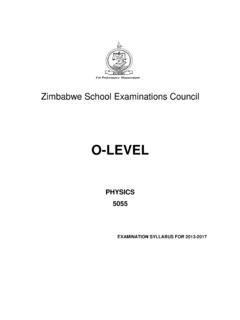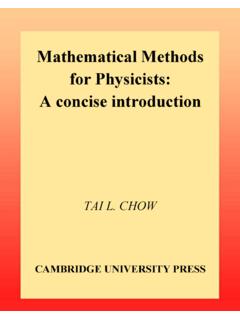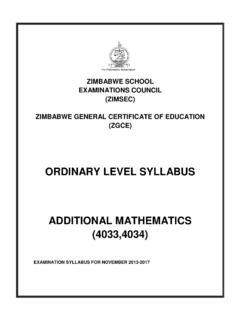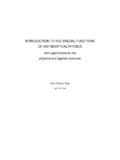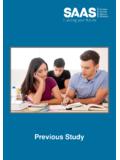Transcription of Applied Mathematics - University of South Africa
1 12 Applied Mathematics (offered by the Department of Mathematical Sciences)Telephone number 012 429 62021 IntroductionApplied Mathematics moves in two broad directions. On the one hand it is the study of mathematical methods used in solving problems which arise in the physical sciences, the biological sciences, engineering, economics and indeed virtually every aspect of life. We might call this the practical side of the subject. On the other hand, Applied Mathematics has a theoretical or descriptive side and this is concerned with the formulation of theories or mathematical must stress, however, that the two aspects of Applied Mathematics are very closely interwoven and one should not try to separate them into water-tight Unisa we have tried to strike a balance between the two aspects of the subject. At fi rst level, APM111 and 112 deal with mechanics which can be regarded as the starting point of theoretical physics.
2 These modules are actually extensions and applications of the calculus modules MAT112 and 113. On the other hand, APM113 and 114 are of a more general nature. At second and third levels , the more general aspects are contained in APM211, 213, 214, 216, 301 and 311 whilst the more theoretical physics aspects are covered by APM212, 312 and 3 in connection with the modules in Mathematics (MAT) required to register for Applied Mathematics on fi rst Requirements for admission to postgraduate studiesStudents must apply for admission to the BSc Honours degree in Applied Mathematics . Each case is treated on its merits and the student s full academic record is taken into consideration. The minimum requirements for admission are either:(a) a Bachelor s degree with Applied Mathematics and Mathematics as major subjects or(b) a Bachelor s degree with Applied Mathematics as major subject, Mathematics II (or the equivalent thereof) and other suitable third-level modules or (b) the other suitable third-level modules could come from Computer Science, Physics, Statistics or any other related particulars can be found in the departmental brochure on postgraduate General Information As from 2001, the modules MAT112 and 113 replace MAT101 and 102 respectively NOTE THAT, with certain exceptions, those who did NOT obtain at least 50% (D symbol) in Mathematics HIGHER GRADE or 80% (A symbol) on STANDARD GRADE at Matriculation level must pass MAT110 BEFORE they register for one or more of APM111, 112, 113 and 114 (see Section 4 below for the specifi c requirements).
3 See the chapter on Mathematics in connection with all the modules in Mathematics (MAT) that are prescribed as Prerequisite and/or co-requisites for the APM modules. Students who register for APM213, APM216 and APM311 must have access to a suitable computer for the practical work (see 5). Students who wish to major in Applied Mathematics and at the end of 1992 had credit for MAT214 (or 203) (which are no longer off ered) but no credit for either APM201 or 202 are advised to contact the Department of Student Admissions and Registration (Tel. 0861 670 411) before registering for any modules in Applied Mathematics . The use of a pocket calculator is permissible in the examination for the following modules: APM111, 112, 113, 114, 213, 214 and 311. Practical work is required with modules APM213, 216 and 311. Credit for a degree is granted for:(i) either APM111 or APM102(ii) either APM111 as from 1994 or PHY105(iii) either APM112 or APM103(iv) either APM213 or COS233(v) either APM311 or COS332(vi) not more than one of APM201, 211 and MAT216(vii) not more than one of APM202, 212 and MAT215 (viii) not more than two of APM211 (or MAT216), APM212 (or MAT215) and MAT214 (or 203)(ix) either APM216 or MAT219(x) either APM312 or PHY310(xi) either APM313 or APM304 and/or 305(xii) either APM215 and APM304 and/or 305(xiii) either APM214 or MAT217(xiv) either APM203 or PHY202(xv)
4 Either APM215 as from 1999 or MAT2183 Applied Mathematics as a Major Subject13 Applied Mathematics as a major subject consists of at least four third-level this regard it should be noted that although Mathematics and Applied Mathematics are very strongly coupled at UNISA, we have nevertheless tried to minimize the mathematical Prerequisite for any given Applied Mathematics are not compelled to take Mathematics as a second major subject but may choose any other subject in the College of Science, Engineering and Technology. Computer Science, Statistics or Physics would probably be the best modules for a major subject combination:First level: Any TWO APM modules, MAT111, 103 and any TWO of MAT101, 102 112, 113 Second level: APM211, 212 and at least ONE other APM module on second levelThird level: FOUR of the following combinations:(a) APM301, 214(b) APM311, 213, COS111(c) APM312(d) APM313(e) MAT306, 211(f) MAT307, 2124 SyllabusNBAll modules in this subject are off ered as YEAR MODULESAPM111S Mechanics IPrerequisite:ONE of the following:(a) at least 50% (D symbol) in Mathematics HIGHER GRADE or 80% (A symbol) on STANDARD GRADE at Matriculation level(b) Mathematics at Matriculation level passed prior to diff erentiation(c) An equivalent examination in Mathematics (see Sc1(1)(b)(iv) in of Part 7 of the Calendar)(d) MAT110(e) PHY101(f) MAT011 passed with at least 75%Purpose.
5 To introduce students to vectors; static equilibrium; uniformly accelerated motion; Newton s laws; work and energy; linear momentum; motion in a circle; rotational work, energy and momentum; mechanical properties of matt er; vibration and Mechanics IIPrerequisite:ONE of the following:(a) At least 50% (D symbol) in Mathematics HIGHER GRADE or 80% (A symbol) on STANDARD GRADE at Matriculation level(b) Mathematics at Matriculation level passed prior to diff erentiation(c) An equivalent examination in Mathematics (see Sc1(1)(b)(iv) in of Part 7 of the Calendar)(d) MAT110(e) MAT011 passed with at least 75%Purpose: to enable students to demonstrate a basic understanding of defi nite integrals, line integrals and the vector product; dynamics of systems of particles and rigid bodies in particular mass centres, moments of forces, moments of inertia and angular Applied linear algebra*Prerequisite:ONE of the following:(a) At least 50% (D symbol) in Mathematics HIGHER GRADE or 80% (A symbol) on STANDARD GRADE at Matriculation level(b) Mathematics at Matriculation level passed prior to diff erentiation(c) An equivalent examination in Mathematics (see Sc1(1)(b)(iv) in Part 7 of the Calendar)(d) MAT110(e) MAT011 passed with at least 75%Purpose: to enable students to master and apply the following aspects of the numerical solution of systems of linear equations: the method of least squares; linear programming (simplex method).
6 Eigenvalues, eigenvectors, diagonalisation as well as some miscellaneous Mathematical modellingPrerequisite:ONE of the following:(a) At least 50% (D symbol) in Mathematics HIGHER GRADE or 80% (A symbol) on STANDARD GRADE at Matriculation level(b) Mathematics at Matriculation level passed prior to diff erentiation(c) An equivalent examination in Mathematics (see Sc1(1)(b)(iv) in Part 7 of the Calendar)(d) MAT110(e) MAT011 passed with at least 75%Purpose: to enable students to demonstrate a basic understanding of solution, equilibrium points and stability of diff erence equations and fi rst-order diff erential equations; applications to population models; harvesting strategies; epidemics; economics and other situations; simple optimisation and MODULES14 APM211V Differential equations*Prerequisite: Any TWO of MAT101, 102, 112, 113 Advice: Aspects of linear algebra, as treated in MAT103, is used in this : to enable students to obtain knowledge of fi rst-order ordinary diff erential equations, linear diff erential equations of higher order, series solutions of diff erential equations (method of Frobenius), Laplace transform and partial diff erential equations (only an introduction).
7 APM212W Calculus in higher dimensionsPrerequisite: MAT111 (or 103) and any TWO of MAT101, 102, 112, 113 Purpose: to enable students to gain a clear knowledge and understanding of vectors in n-space, functions from n-space to m-space, various types of derivatives (grad, div, curl, directional derivatives), higher-order partial derivatives, inverse and implicit functions, double integrals, triple integrals, line integrals and surface integrals, and the theorems of Green, Gauss and Numerical methods 1 (3 hours)*Prerequisite: COS111, MAT111, 103 and any TWO of MAT101, 102, 112, 113 Purpose: to introduce students to numerical solutions of non-linear equations and systems of linear equations; interpolating polynomials, numerical integration and diff erentiation, least-squares Applied dynamical systemsPrerequisite: Any three of MAT111, 101, 102, 103, 112, 113 Purpose: to enable students to master and apply fundamental aspects of discrete and continuous systems including linear systems; phase portraits: equilibrium points, stability, limit cycles; Liapunov stability.
8 Elementary control theory as well as applications to mechanics, ecology, economics and Computer algebraPrerequisite: COS111, MAT111, 103 or APM113, MAT112 or (MAT101 and MAT102)Purpose: to give students an understanding of the power of modern computer algebra systems, and specifi cally to enable students to use computer algebra to solve analytically a variety of mathematical problems including the algebraic equations (both linear and nonlinear), diff erentiation, integration, diff erential equations, matrix manipulation, series expansions, and limits; and to represent mathematical functions graphically, 2D and 3D, and to produce mathematical MODULESAPM301W Partial differential equations*Prerequisite: Any two APM or MAT modules on second levelAdvice: The content of APM211 (or MAT216) is assumed as known in this : to introduce students to the following topics in partial diff erential equations.
9 The equation of Laplace, the heat equation and the wave equation treated as typical examples of elliptic, parabolic and hyperbolic partial diff erential equations respectively, and methods of solution of the corresponding boundary value problems are also Numerical methods 2*Prerequisite: APM213 or COS233 Purpose: to enable students to demonstrate a basic understanding of numerical solution methods for ordinary diff erential equations and boundary value problems, numerical solution methods for elliptic partial diff erential equations, and function Mechanics and the calculus of variationsPrerequisite: Any two APM or MAT modules on second levelAdvice: The modules APM212 (or MAT215) and PHY201 contain useful background : to enable students to demonstrate a basic understanding of generalised coordinates, Hamilton s principle, calculus of variations and the Euler-Lagrange equations, the problem of Lagrange and the isoperimetric problem, Hamilton-Jacobi theory and Poisson brackets, Equivalent Lagrangians, canonical transformations and Noether s theorem and application of the variational principles in Special relativity and Riemannian geometry*Prerequisite: Any two APM or MAT modules on second levelAdvice: The module APM212/MAT215 contains useful background : to introduce students to the geometry of curves and surfaces in 3-dimensional Euclidean space, the special theory of relativity, Riemannian geometry and tensor Practical Work and Admission RequirementsPractical work in APM213, 216 and APM311 mainly comprises the writing of computer programs.
10 The programs have to be developed on suitable computers using prescribed computer packages. Access to a suitable computer is an admission requirement for all modules with a practical component. Students can gain access as follows:(i) by purchasing a computer for their own use; or(ii) by using a computer belonging to a study group, friend, computer bureau, or employer; or(iii) by reserving time on a computer at one of Unisa s microcomputer laboratories in Pretoria, Polokwane, Cape Town, and Durban. The minimum confi guration of a suitable computer is described as follows:A computer which has the following minimum confi guration: Pentium 75 MHz processor or faster VGA or higher graphics Windows 95 or later version Hard disk 1 Gigabyte or bigger 16 MB RAM (32 MB or higher recommended by some soft ware) A CD-ROM drive15 A inch high-density ( MB) diskett e drive A printer that can print both text and graphics (minimum A4 paper size)A compiler for any suitable programming language is an additional requirement for APM213 and CANNOT supply any of the commercial soft ware packages mentioned.

